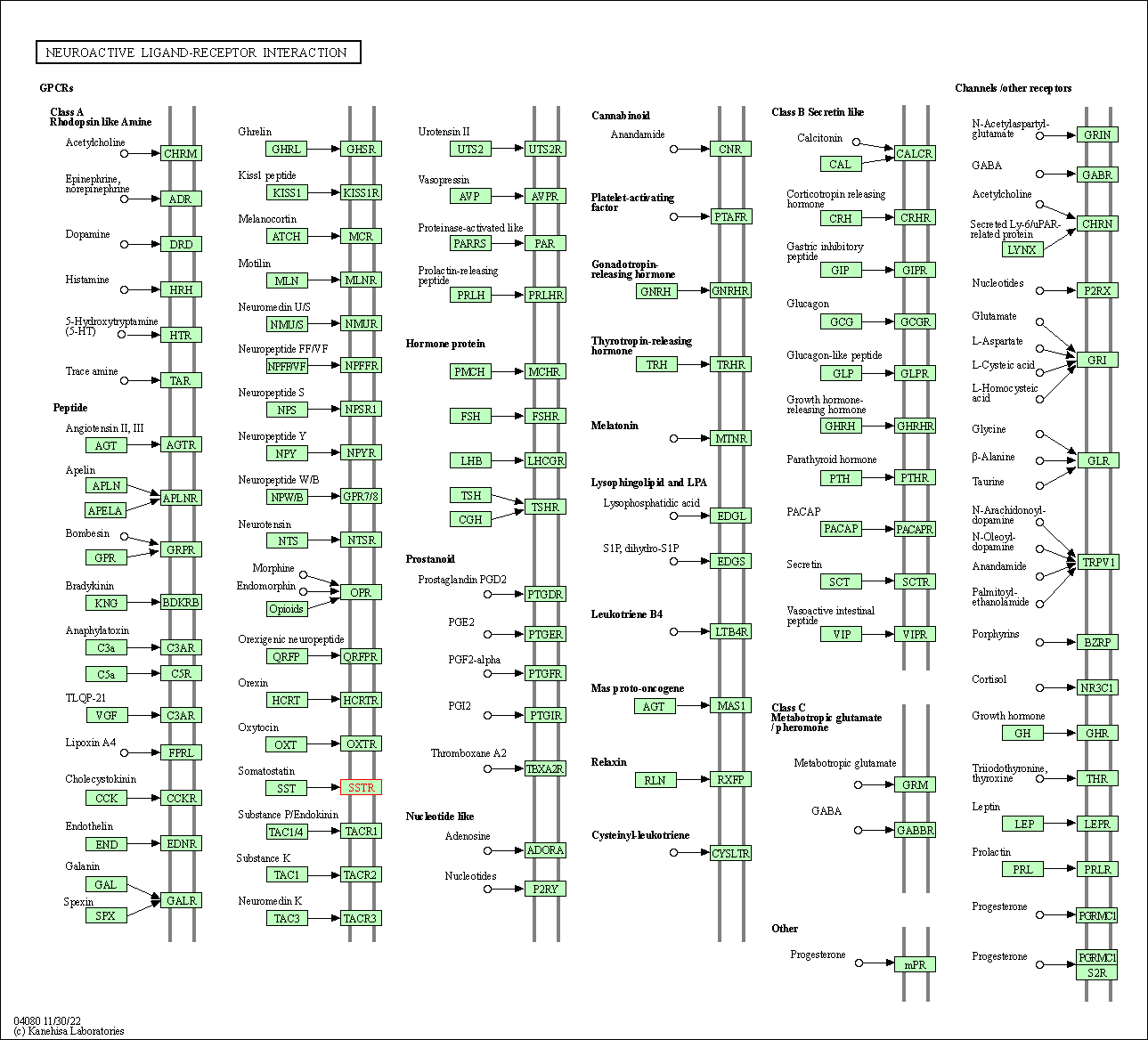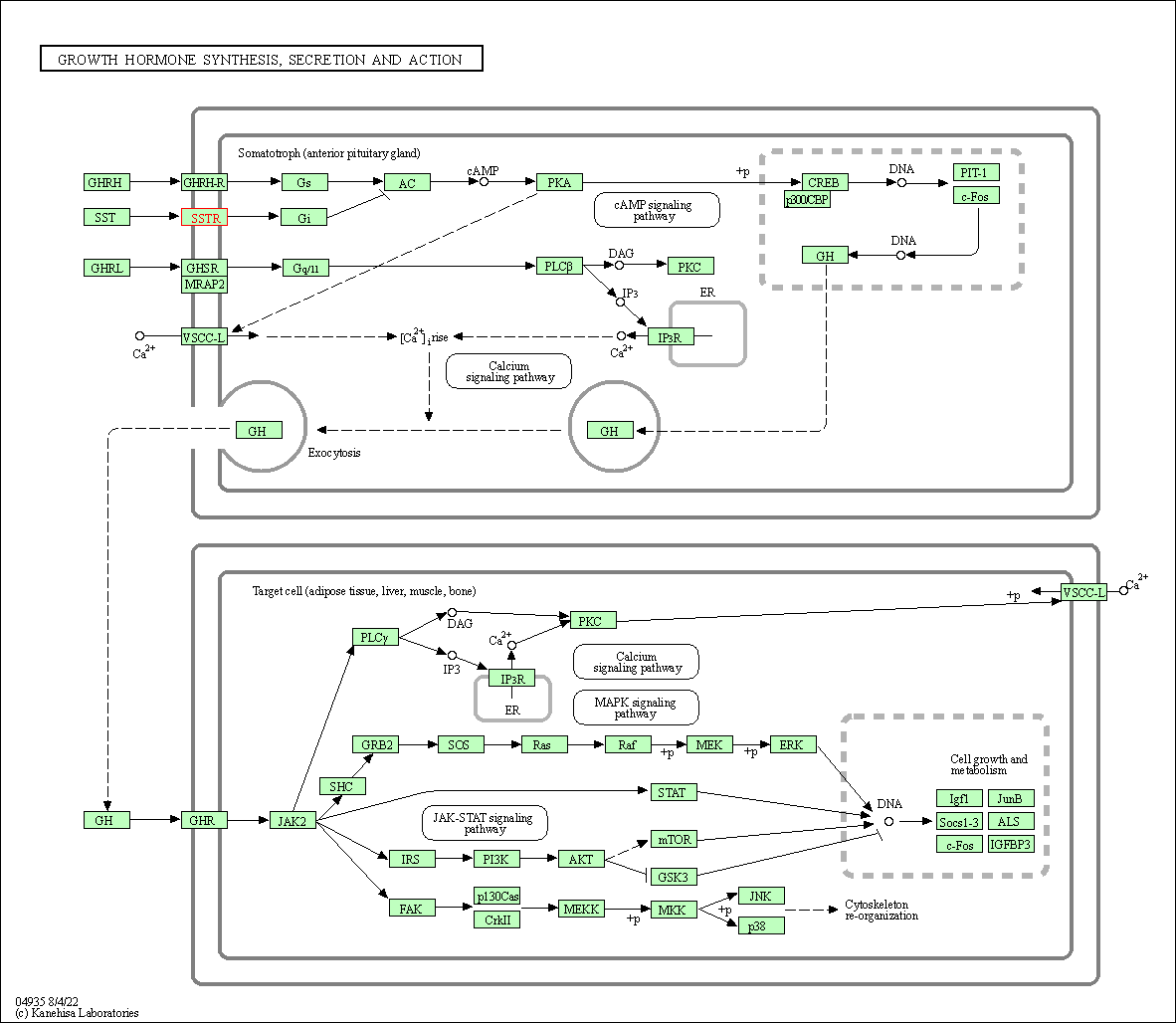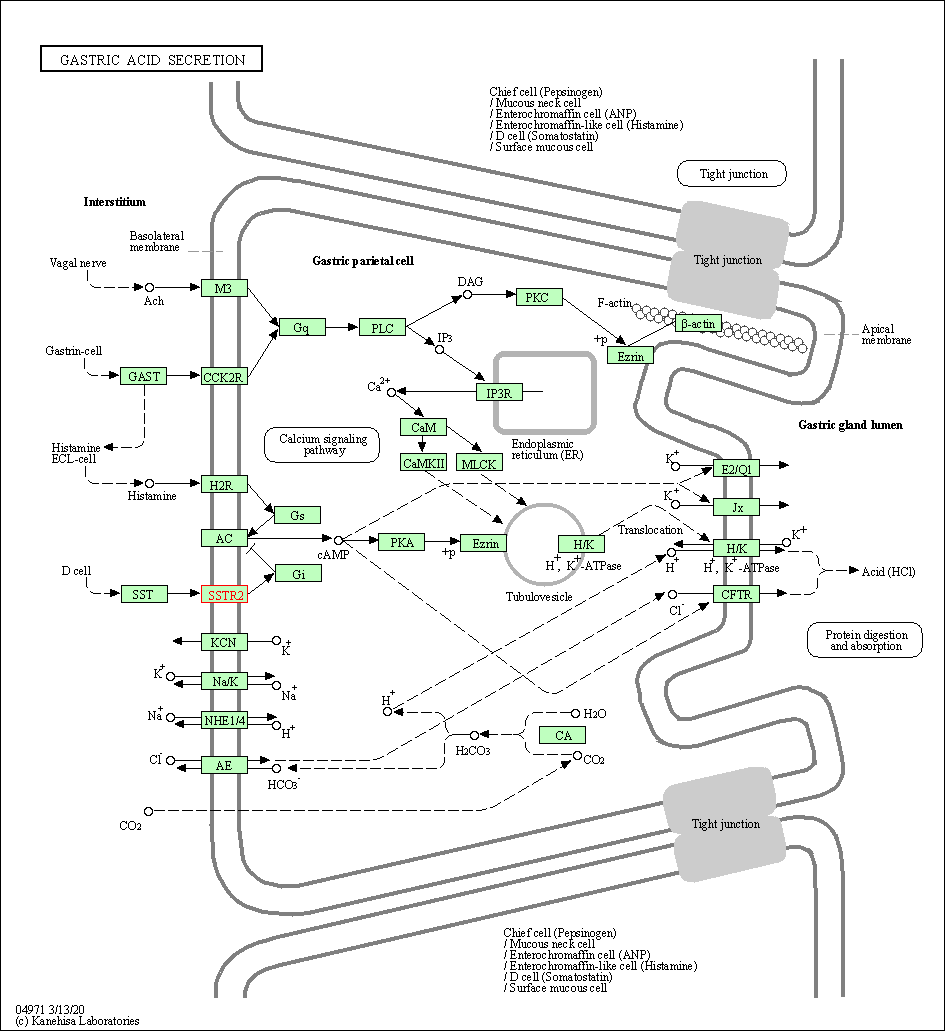Target Information
| Target General Information | Top | |||||
|---|---|---|---|---|---|---|
| Target ID |
T53024
(Former ID: TTDS00394)
|
|||||
| Target Name |
Somatostatin receptor type 2 (SSTR2)
|
|||||
| Synonyms |
Sst(2); Somatostatin receptor 2; SS2R; SS2-R; SS-2-R; SRIF-1
Click to Show/Hide
|
|||||
| Gene Name |
SSTR2
|
|||||
| Target Type |
Successful target
|
[1] | ||||
| Disease | [+] 3 Target-related Diseases | + | ||||
| 1 | Cushing syndrome [ICD-11: 5A70] | |||||
| 2 | Diagnostic imaging [ICD-11: N.A.] | |||||
| 3 | Pituitary gland disorder [ICD-11: 5A60-5A61] | |||||
| Function |
Receptor for somatostatin-14 and -28. This receptor is coupled via pertussis toxin sensitive G proteins to inhibition of adenylyl cyclase. In addition it stimulates phosphotyrosine phosphatase and PLC via pertussis toxin insensitive as well as sensitive G proteins. Inhibits calcium entry by suppressing voltage-dependent calcium channels. Acts as the functionally dominant somatostatin receptor in pancreatic alpha- and beta-cells where it mediates the inhibitory effect of somatostatin-14 on hormone secretion. Inhibits cell growth through enhancement of MAPK1 and MAPK2 phosphorylation and subsequent up-regulation of CDKN1B. Stimulates neuronal migration and axon outgrowth and may participate in neuron development and maturation during brain development. Mediates negative regulation of insulin receptor signaling through PTPN6. Inactivates SSTR3 receptor function following heterodimerization.
Click to Show/Hide
|
|||||
| BioChemical Class |
GPCR rhodopsin
|
|||||
| UniProt ID | ||||||
| Sequence |
MDMADEPLNGSHTWLSIPFDLNGSVVSTNTSNQTEPYYDLTSNAVLTFIYFVVCIIGLCG
NTLVIYVILRYAKMKTITNIYILNLAIADELFMLGLPFLAMQVALVHWPFGKAICRVVMT VDGINQFTSIFCLTVMSIDRYLAVVHPIKSAKWRRPRTAKMITMAVWGVSLLVILPIMIY AGLRSNQWGRSSCTINWPGESGAWYTGFIIYTFILGFLVPLTIICLCYLFIIIKVKSSGI RVGSSKRKKSEKKVTRMVSIVVAVFIFCWLPFYIFNVSSVSMAISPTPALKGMFDFVVVL TYANSCANPILYAFLSDNFKKSFQNVLCLVKVSGTDDGERSDSKQDKSRLNETTETQRTL LNGDLQTSI Click to Show/Hide
|
|||||
| 3D Structure | Click to Show 3D Structure of This Target | AlphaFold | ||||
| HIT2.0 ID | T85QFY | |||||
| Drugs and Modes of Action | Top | |||||
|---|---|---|---|---|---|---|
| Approved Drug(s) | [+] 3 Approved Drugs | + | ||||
| 1 | Lanreotide acetate | Drug Info | Approved | Acromegaly | [4], [5], [6] | |
| 2 | Octreotide | Drug Info | Approved | Acromegaly | [7], [8] | |
| 3 | Pasireotide | Drug Info | Approved | Cushing disease | [9], [10] | |
| Clinical Trial Drug(s) | [+] 1 Clinical Trial Drugs | + | ||||
| 1 | Re-188-P-2045 | Drug Info | Phase 1/2 | Lung cancer | [14] | |
| Discontinued Drug(s) | [+] 1 Discontinued Drugs | + | ||||
| 1 | FR-121196 | Drug Info | Terminated | Alzheimer disease | [15] | |
| Mode of Action | [+] 5 Modes of Action | + | ||||
| Modulator | [+] 4 Modulator drugs | + | ||||
| 1 | Lanreotide acetate | Drug Info | [4], [6] | |||
| 2 | Re-188-P-2045 | Drug Info | [14] | |||
| 3 | FR-121196 | Drug Info | [18] | |||
| 4 | 99mTc-MIP-1407 | Drug Info | [16] | |||
| Binder | [+] 1 Binder drugs | + | ||||
| 1 | Octreotide | Drug Info | [1] | |||
| Inhibitor | [+] 21 Inhibitor drugs | + | ||||
| 1 | Pasireotide | Drug Info | [16] | |||
| 2 | ODT-8 | Drug Info | [17] | |||
| 3 | Ala11-SRIF-14-amide | Drug Info | [19] | |||
| 4 | Ala7-SRIF-14-amide | Drug Info | [19] | |||
| 5 | Cytotoxin Peptide Conjugate | Drug Info | [21] | |||
| 6 | D-Phe-c[Cys-Tyr-D-Trp-Lys-Val-Cys]-Asp-NH2 | Drug Info | [22] | |||
| 7 | Des-AA1,2,4,12,13-[D-Trp8]SRIF | Drug Info | [17] | |||
| 8 | Des-AA1,2,4,13-[D-Trp8]SRIF | Drug Info | [17] | |||
| 9 | Des-AA1,2,4,5,11,12,13-[D-Trp8]SRIF | Drug Info | [17] | |||
| 10 | Des-AA1,2,4,5-[D-Trp8]SRIF | Drug Info | [17] | |||
| 11 | Des-AA1,2,5,12,13-[D-Trp8]SRIF | Drug Info | [17] | |||
| 12 | Des-AA1,2,5-[D-Trp8,Tyr11]SRIF | Drug Info | [23] | |||
| 13 | Des-AA5-[D-Trp8]SRIF | Drug Info | [23] | |||
| 14 | H-c[Cys-Phe-DTrp-Lys-Thr-Cys]-OH | Drug Info | [24] | |||
| 15 | H-D-Phe-Cys-Tyr-D-Trp-Lys-Val-Cys-Thr-NH2 | Drug Info | [22] | |||
| 16 | H-D-Phe-c[Cys-Ala-D-Trp-Lys-Thr-Cys]-Thr-NH2 | Drug Info | [24] | |||
| 17 | H-DPhe-c[Cys-Phe-DTrp-Lys-Thr-Cys]-Thr-NH2 | Drug Info | [24] | |||
| 18 | Pyz11-D-Trp8-SRIF | Drug Info | [19] | |||
| 19 | Pyz6-D-Trp8-SRIF | Drug Info | [19] | |||
| 20 | SOMATOSTATIN | Drug Info | [22] | |||
| 21 | SRIF-28 | Drug Info | [27] | |||
| Antagonist | [+] 1 Antagonist drugs | + | ||||
| 1 | 98mTc-CIM-ANT | Drug Info | [16] | |||
| Agonist | [+] 5 Agonist drugs | + | ||||
| 1 | CGP 23996 | Drug Info | [20] | |||
| 2 | L-054,522 | Drug Info | [25] | |||
| 3 | L-054852 | Drug Info | [4] | |||
| 4 | L-779,976 | Drug Info | [26] | |||
| 5 | SRIF-14 | Drug Info | [20] | |||
| Cell-based Target Expression Variations | Top | |||||
|---|---|---|---|---|---|---|
| Cell-based Target Expression Variations | ||||||
| Drug Binding Sites of Target | Top | |||||
|---|---|---|---|---|---|---|
| Ligand Name: Cholesterol | Ligand Info | |||||
| Structure Description | Cryo-EM structure of the SST-14-bound SSTR2-miniGq-scFv16 complex | PDB:7Y27 | ||||
| Method | Electron microscopy | Resolution | 3.48 Å | Mutation | Yes | [28] |
| PDB Sequence |
LTSNAVLTFI
49 YFVVCIIGLC59 GNTLVIYVIL69 RYAKMKTITN79 IYILNLAIAD89 ELFMLGLPFL 99 AMQVALVHWP109 FGKAICRVVM119 TVDGINQFTS129 IFCLTVMSID139 RYLAVVHPIK 149 SAKWRRPRTA159 KMITMAVWGV169 SLLVILPIMI179 YAGLRSNQWG189 RSSCTINWPG 202 AWYTGFIIYT212 FILGFLVPLT222 IICLCYLFII232 IKVKSSKSEK252 KVTRMVSIVV 262 AVFIFCWLPF272 YIFNVSSVSM282 AISPTPALKG292 MFDFVVVLTY302 ANSCANPILY 312 AFLSDNFKKS322 FQNV
|
|||||
|
|
||||||
| Ligand Name: (1R,1'S,3'R/1R,1'R,3'S)-L-054,264 | Ligand Info | |||||
| Structure Description | Cryo-EM structure of the L-054,264-bound human SSTR2-Gi1 complex | PDB:7WIG | ||||
| Method | Electron microscopy | Resolution | 2.70 Å | Mutation | No | [29] |
| PDB Sequence |
LTSNAVLTFI
49 YFVVCIIGLC59 GNTLVIYVIL69 RTITNIYILN84 LAIADELFML94 GLPFLAMQVA 104 LVHWPFGKAI114 CRVVMTVDGI124 NQFTSIFCLT134 VMSIDRYLAV144 VHPIKSAKWR 154 RPRTAKMITM164 AVWGVSLLVI174 LPIMIYAGLR184 SNQWGRSSCT194 INWPGESGAW 204 YTGFIIYTFI214 LGFLVPLTII224 CLCYLFIIIK234 VKSSGIRVGS244 SKRKKSEKKV 254 TRMVSIVVAV264 FIFCWLPFYI274 FNVSSVSMAI284 SPTPALKGMF294 DFVVVLTYAN 304 SCANPILYAF314 LSDNFKKSFQ324 NVL
|
|||||
|
|
PHE92
4.804
LEU99
4.765
MET119
4.027
ASP122
2.500
GLN126
2.844
PHE127
4.450
ILE177
4.988
THR194
4.410
ILE195
4.602
TYR205
4.056
PHE208
4.512
THR212
4.286
PHE272
2.896
|
|||||
| Click to View More Binding Site Information of This Target with Different Ligands | ||||||
| Different Human System Profiles of Target | Top |
|---|---|
|
Human Similarity Proteins
of target is determined by comparing the sequence similarity of all human proteins with the target based on BLAST. The similarity proteins for a target are defined as the proteins with E-value < 0.005 and outside the protein families of the target.
A target that has fewer human similarity proteins outside its family is commonly regarded to possess a greater capacity to avoid undesired interactions and thus increase the possibility of finding successful drugs
(Brief Bioinform, 21: 649-662, 2020).
Human Tissue Distribution
of target is determined from a proteomics study that quantified more than 12,000 genes across 32 normal human tissues. Tissue Specificity (TS) score was used to define the enrichment of target across tissues.
The distribution of targets among different tissues or organs need to be taken into consideration when assessing the target druggability, as it is generally accepted that the wider the target distribution, the greater the concern over potential adverse effects
(Nat Rev Drug Discov, 20: 64-81, 2021).
Human Pathway Affiliation
of target is determined by the life-essential pathways provided on KEGG database. The target-affiliated pathways were defined based on the following two criteria (a) the pathways of the studied target should be life-essential for both healthy individuals and patients, and (b) the studied target should occupy an upstream position in the pathways and therefore had the ability to regulate biological function.
Targets involved in a fewer pathways have greater likelihood to be successfully developed, while those associated with more human pathways increase the chance of undesirable interferences with other human processes
(Pharmacol Rev, 58: 259-279, 2006).
Biological Network Descriptors
of target is determined based on a human protein-protein interactions (PPI) network consisting of 9,309 proteins and 52,713 PPIs, which were with a high confidence score of ≥ 0.95 collected from STRING database.
The network properties of targets based on protein-protein interactions (PPIs) have been widely adopted for the assessment of target’s druggability. Proteins with high node degree tend to have a high impact on network function through multiple interactions, while proteins with high betweenness centrality are regarded to be central for communication in interaction networks and regulate the flow of signaling information
(Front Pharmacol, 9, 1245, 2018;
Curr Opin Struct Biol. 44:134-142, 2017).
Human Similarity Proteins
Human Tissue Distribution
Human Pathway Affiliation
Biological Network Descriptors
|
|
|
Note:
If a protein has TS (tissue specficity) scores at least in one tissue >= 2.5, this protein is called tissue-enriched (including tissue-enriched-but-not-specific and tissue-specific). In the plots, the vertical lines are at thresholds 2.5 and 4.
|
| KEGG Pathway | Pathway ID | Affiliated Target | Pathway Map |
|---|---|---|---|
| cAMP signaling pathway | hsa04024 | Affiliated Target |

|
| Class: Environmental Information Processing => Signal transduction | Pathway Hierarchy | ||
| Neuroactive ligand-receptor interaction | hsa04080 | Affiliated Target |

|
| Class: Environmental Information Processing => Signaling molecules and interaction | Pathway Hierarchy | ||
| Growth hormone synthesis, secretion and action | hsa04935 | Affiliated Target |

|
| Class: Organismal Systems => Endocrine system | Pathway Hierarchy | ||
| Gastric acid secretion | hsa04971 | Affiliated Target |

|
| Class: Organismal Systems => Digestive system | Pathway Hierarchy | ||
| Degree | 1 | Degree centrality | 1.07E-04 | Betweenness centrality | 0.00E+00 |
|---|---|---|---|---|---|
| Closeness centrality | 1.49E-01 | Radiality | 1.19E+01 | Clustering coefficient | 0.00E+00 |
| Neighborhood connectivity | 8.00E+00 | Topological coefficient | 1.00E+00 | Eccentricity | 14 |
| Download | Click to Download the Full PPI Network of This Target | ||||
| Chemical Structure based Activity Landscape of Target | Top |
|---|---|
| Drug Property Profile of Target | Top | |
|---|---|---|
| (1) Molecular Weight (mw) based Drug Clustering | (2) Octanol/Water Partition Coefficient (xlogp) based Drug Clustering | |
|
|
||
| (3) Hydrogen Bond Donor Count (hbonddonor) based Drug Clustering | (4) Hydrogen Bond Acceptor Count (hbondacc) based Drug Clustering | |
|
|
||
| (5) Rotatable Bond Count (rotbonds) based Drug Clustering | (6) Topological Polar Surface Area (polararea) based Drug Clustering | |
|
|
||
| "RO5" indicates the cutoff set by lipinski's rule of five; "D123AB" colored in GREEN denotes the no violation of any cutoff in lipinski's rule of five; "D123AB" colored in PURPLE refers to the violation of only one cutoff in lipinski's rule of five; "D123AB" colored in BLACK represents the violation of more than one cutoffs in lipinski's rule of five | ||
| Co-Targets | Top | |||||
|---|---|---|---|---|---|---|
| Co-Targets | ||||||
| Target Poor or Non Binders | Top | |||||
|---|---|---|---|---|---|---|
| Target Poor or Non Binders | ||||||
| Target Regulators | Top | |||||
|---|---|---|---|---|---|---|
| Target-regulating Transcription Factors | ||||||
| Target Profiles in Patients | Top | |||||
|---|---|---|---|---|---|---|
| Target Expression Profile (TEP) | ||||||
| Target Affiliated Biological Pathways | Top | |||||
|---|---|---|---|---|---|---|
| KEGG Pathway | [+] 3 KEGG Pathways | + | ||||
| 1 | cAMP signaling pathway | |||||
| 2 | Neuroactive ligand-receptor interaction | |||||
| 3 | Gastric acid secretion | |||||
| Panther Pathway | [+] 2 Panther Pathways | + | ||||
| 1 | Heterotrimeric G-protein signaling pathway-Gi alpha and Gs alpha mediated pathway | |||||
| 2 | Heterotrimeric G-protein signaling pathway-Gq alpha and Go alpha mediated pathway | |||||
| Reactome | [+] 2 Reactome Pathways | + | ||||
| 1 | Peptide ligand-binding receptors | |||||
| 2 | G alpha (i) signalling events | |||||
| WikiPathways | [+] 6 WikiPathways | + | ||||
| 1 | SIDS Susceptibility Pathways | |||||
| 2 | GPCRs, Class A Rhodopsin-like | |||||
| 3 | Peptide GPCRs | |||||
| 4 | GPCR ligand binding | |||||
| 5 | GPCR downstream signaling | |||||
| 6 | GPCRs, Other | |||||
| Target-Related Models and Studies | Top | |||||
|---|---|---|---|---|---|---|
| Target Validation | ||||||
| References | Top | |||||
|---|---|---|---|---|---|---|
| REF 1 | Versatile conjugation of octreotide to dendrimers by cycloaddition ("click") chemistry to yield high-affinity multivalent cyclic Peptide dendrimers. Bioconjug Chem. 2009 Jul;20(7):1323-31. | |||||
| REF 2 | Drugs@FDA. U.S. Food and Drug Administration. U.S. Department of Health Human Services. 2019 | |||||
| REF 3 | Drugs@FDA. U.S. Food and Drug Administration. U.S. Department of Health Human Services. 2020 | |||||
| REF 4 | Treatment strategies for acromegaly. Expert Opin Emerg Drugs. 2005 Nov;10(4):875-90. | |||||
| REF 5 | URL: http://www.guidetopharmacology.org Nucleic Acids Res. 2015 Oct 12. pii: gkv1037. The IUPHAR/BPS Guide to PHARMACOLOGY in 2016: towards curated quantitative interactions between 1300 protein targets and 6000 ligands. (Ligand id: 2031). | |||||
| REF 6 | Pasireotide, a multi-somatostatin receptor ligand with potential efficacy for treatment of pituitary and neuroendocrine tumors. Drugs Today (Barc). 2013 Feb;49(2):89-103. | |||||
| REF 7 | URL: http://www.guidetopharmacology.org Nucleic Acids Res. 2015 Oct 12. pii: gkv1037. The IUPHAR/BPS Guide to PHARMACOLOGY in 2016: towards curated quantitative interactions between 1300 protein targets and 6000 ligands. (Ligand id: 2055). | |||||
| REF 8 | Emerging drugs for complications of end-stage liver disease. Expert Opin Emerg Drugs. 2008 Mar;13(1):159-74. | |||||
| REF 9 | Drugs@FDA. U.S. Food and Drug Administration. U.S. Department of Health & Human Services. 2015 | |||||
| REF 10 | ClinicalTrials.gov (NCT02527993) Treatment of Hypoglycemia Following Gastric Bypass Surgery. | |||||
| REF 11 | ClinicalTrials.gov (NCT04837040) A Randomized, Controlled, Multi-Center Study to Evaluate the Safety and Efficacy of Paltusotine in Subjects With Acromegaly Treated With Long-acting Somatostatin Receptor Ligands (PATHFNDR-1). U.S.National Institutes of Health. | |||||
| REF 12 | ClinicalTrials.gov (NCT04335357) TBR-760 in Adult Patients With Non-Functioning Pituitary Adenomas. U.S. National Institutes of Health. | |||||
| REF 13 | Clinical pipeline report, company report or official report of the Pharmaceutical Research and Manufacturers of America (PhRMA) | |||||
| REF 14 | The somatostatin analog 188Re-P2045 inhibits the growth of AR42J pancreatic tumor xenografts. J Nucl Med. 2014 Dec;55(12):2020-5. | |||||
| REF 15 | Trusted, scientifically sound profiles of drug programs, clinical trials, safety reports, and company deals, written by scientists. Springer. 2015. Adis Insight (drug id 800001380) | |||||
| REF 16 | URL: http://www.guidetopharmacology.org Nucleic Acids Res. 2015 Oct 12. pii: gkv1037. The IUPHAR/BPS Guide to PHARMACOLOGY in 2016: towards curated quantitative interactions between 1300 protein targets and 6000 ligands. (Target id: 356). | |||||
| REF 17 | Somatostatin receptor 1 selective analogues: 3. Dicyclic peptides. J Med Chem. 2005 Jan 27;48(2):515-22. | |||||
| REF 18 | Role of somatostatin in the augmentation of hippocampal long-term potentiation by FR121196, a putative cognitive enhancer. Eur J Pharmacol. 1993 Sep 7;241(1):27-34. | |||||
| REF 19 | Replacement of Phe6, Phe7, and Phe11 of D-Trp8-somatostatin-14 with L-pyrazinylalanine. Predicted and observed effects on binding affinities at hSS... J Med Chem. 2005 Jun 16;48(12):4025-30. | |||||
| REF 20 | [125I][Tyr3]octreotide labels human somatostatin sst2 and sst5 receptors. Eur J Pharmacol. 1998 May 8;348(2-3):311-20. | |||||
| REF 21 | An adjustable release rate linking strategy for cytotoxin-peptide conjugates. Bioorg Med Chem Lett. 2003 Mar 10;13(5):799-803. | |||||
| REF 22 | Discovery of iodinated somatostatin analogues selective for hsst2 and hsst5 with excellent inhibition of growth hormone and prolactin release from ... J Med Chem. 2005 Oct 20;48(21):6643-52. | |||||
| REF 23 | Somatostatin receptor 1 selective analogues: 2. N(alpha)-Methylated scan. J Med Chem. 2005 Jan 27;48(2):507-14. | |||||
| REF 24 | Novel sst2-selective somatostatin agonists. Three-dimensional consensus structure by NMR. J Med Chem. 2006 Jul 27;49(15):4487-96. | |||||
| REF 25 | Synthesis and biological activities of potent peptidomimetics selective for somatostatin receptor subtype 2. Proc Natl Acad Sci U S A. 1998 Sep 1;95(18):10836-41. | |||||
| REF 26 | Rapid identification of subtype-selective agonists of the somatostatin receptor through combinatorial chemistry. Science. 1998 Oct 23;282(5389):737-40. | |||||
| REF 27 | Novel octreotide dicarba-analogues with high affinity and different selectivity for somatostatin receptors. J Med Chem. 2010 Aug 26;53(16):6188-97. | |||||
| REF 28 | Molecular basis for the selective G protein signaling of somatostatin receptors. Nat Chem Biol. 2023 Feb;19(2):133-140. | |||||
| REF 29 | Structures of the endogenous peptide- and selective non-peptide agonist-bound SSTR2 signaling complexes. Cell Res. 2022 Aug;32(8):785-788. | |||||
If You Find Any Error in Data or Bug in Web Service, Please Kindly Report It to Dr. Zhou and Dr. Zhang.

